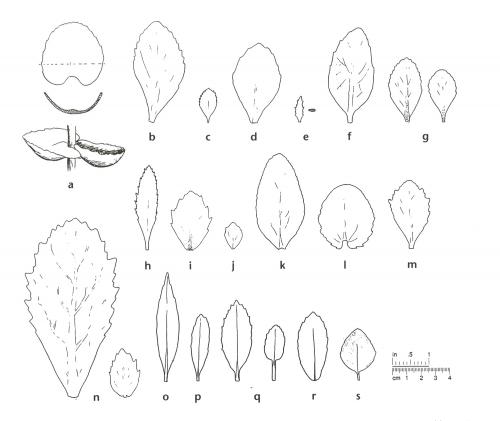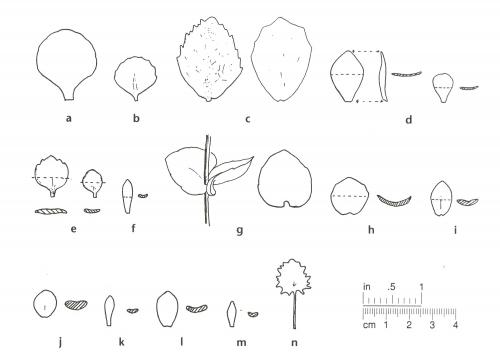Leaf shapes of genus Hylotelephium
Ray Stephenson in "Sedum Cultivated Stonecrops",1994, pp 269 - 270 :
Figure 1

(a) H. causasicum has amplexicaul, cupped leaves in opposite pairs.
(b) H. erythrosticum
(c) H. sordidum
(d) H. spectabile leaf of a potted plant - leaves of plants in a rich border can be twice this size (area).
(e) H. tatarinowii
(f) H. telephioides
(g) H. telephium ssp. fabaria [See H. telephium ssp. telephium]
(h) H. telephium ssp. fabaria var. borderi [See H. telephium ssp. telephium]
(i) 'Ruby Glow'
(j) 'Vera Jameson'
(k) H. telephium ssp. maximum
(I) H. telephium ssp. ruprechtii
(m) H. telephium ssp. telephium
(n) 'Autumn Joy' ['Herbstfreude']possesses the largest of all Hylotelephium leaves but its upper leaves are much smaller than and rather different in shape from the large lower ones
(o) H. verticillatum mainland form
(p) H. verticillatum var. nipponicum
(q) H. viride
(r) H. viridescens leaf
(s) H. viviparum leaves are not succulent.
Figure 2

(a) H. ettyuense
(b) H. sieboldii
(c) H. tsugaruense (left) typical leaf (and right) extreme form
(d) H. anacampseros leaves are very varied in shape but usually are clustered in terminal rosettes.
(e) H. cauticola (left) form from Mount Apoi, Japan (and right) 'Lidakense'
(f) H. cyaneum
(g) H. ewersii ssp. ewersii (left) pairs of leaves are well spaced on long stems and (right) leaves are amplexicaul.
(h) H. ewersii var. cyclophyllum
(i) H. ewersii var. homophyllum
(j) H. pluricaule var. pluricaule
(k) H. pluricaule ssp. ezawae
(I) H. pluricaule var. yezoense
(m) H. pluricaule var. yezoense from Rebun Island
(n) H. populifolium leaves can be much larger than this but are always just as anomalous.